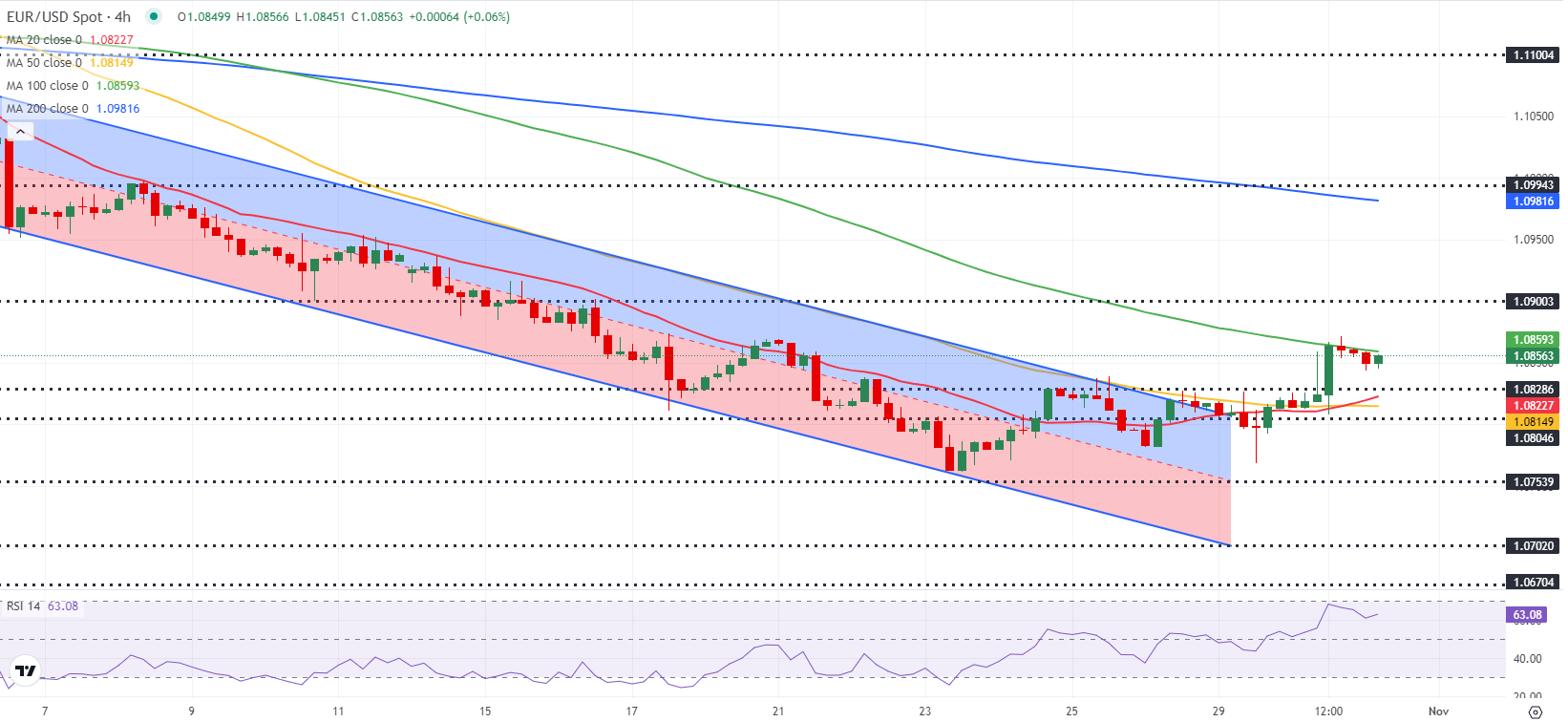- EUR/USD stays in a consolidation phase near 1.0850 after posting gains on Wednesday.
- The 200-day SMA aligns as key technical resistance at 1.0870.
- Markets await inflation data from the Euro area and the US.
EUR/USD fluctuates in a tight channel at around 1.0850 after closing the third consecutive day in positive territory on Wednesday. The near-term technical outlook suggests that the bullish bias remains intact but buyers could hesitate to bet on an extended uptrend unless the pair manages to clear the key technical hurdle at 1.0870.
Euro PRICE This week
The table below shows the percentage change of Euro (EUR) against listed major currencies this week. Euro was the strongest against the Australian Dollar.
| USD | EUR | GBP | JPY | CAD | AUD | NZD | CHF | |
|---|---|---|---|---|---|---|---|---|
| USD | -0.58% | -0.15% | -0.43% | 0.18% | 0.45% | 0.10% | -0.23% | |
| EUR | 0.58% | 0.53% | 0.07% | 0.76% | 1.12% | 0.68% | 0.37% | |
| GBP | 0.15% | -0.53% | 0.36% | 0.34% | 0.64% | 0.22% | 0.08% | |
| JPY | 0.43% | -0.07% | -0.36% | 0.67% | 0.25% | -0.21% | -0.28% | |
| CAD | -0.18% | -0.76% | -0.34% | -0.67% | 0.24% | -0.15% | -0.38% | |
| AUD | -0.45% | -1.12% | -0.64% | -0.25% | -0.24% | -0.46% | -0.74% | |
| NZD | -0.10% | -0.68% | -0.22% | 0.21% | 0.15% | 0.46% | -0.33% | |
| CHF | 0.23% | -0.37% | -0.08% | 0.28% | 0.38% | 0.74% | 0.33% |
The heat map shows percentage changes of major currencies against each other. The base currency is picked from the left column, while the quote currency is picked from the top row. For example, if you pick the Euro from the left column and move along the horizontal line to the US Dollar, the percentage change displayed in the box will represent EUR (base)/USD (quote).
The Euro gathered strength against its rivals on Wednesday after the data from Germany showed that the Gross Domestic Product (GDP) expanded by 0.2% on a quarterly basis in the third quarter, coming in better than the market expectation for a 0.1% contraction. Additionally, annual inflation in Germany, as measured by the Consumer price Index (CPI) rose to 2% in October's flash estimate from 1.6% in September, further boosting the Euro.
On the other hand, mixed macroeconomic data releases from the US made it difficult for the US Dollar (USD) to stay resilient against its rivals. The ADP Employment Change arrived at 233,000 for October to beat analysts' estimate by a wide margin, while the first estimate of the annualized GDP growth for the third quarter came in at 2.8% and fell short of the market consensus of 3%.
Later in the day, the Harmonized Index of Consumer Prices (HICP) data from the Eurozone and the Personal Consumption Expenditures (PCE) Price Index figures from the US will be featured in the economic calendar. Investors are likely to ignore these readings. The US GDP report showed on Wednesday that the PCE Price Index rose 1.5% in Q3, down from 2.5% in Q2. Hence, the monthly PCE inflation reading for September is unlikely to trigger a reaction.
Toward the end of the European session, month-end flows could ramp up market volatility and cause major pairs to move irregularly.
EUR/USD Technical Analysis
The Relative Strength Index (RSI) indicator on the 4-hour chart holds above 60, suggesting that the bullish bias remains intact. On the upside, the 200-day Simple Moving Average (SMA) aligns as a key resistance level at 1.0870. Once the pair flips that level into support, 1.0900 (round level) could act as interim resistance before 1.0940 (100-day SMA).
On the downside, first support could be seen at 1.0800 (round level) before 1.0750 (static level) and 1.0700 (round level, static level).
Euro FAQs
The Euro is the currency for the 19 European Union countries that belong to the Eurozone. It is the second most heavily traded currency in the world behind the US Dollar. In 2022, it accounted for 31% of all foreign exchange transactions, with an average daily turnover of over $2.2 trillion a day. EUR/USD is the most heavily traded currency pair in the world, accounting for an estimated 30% off all transactions, followed by EUR/JPY (4%), EUR/GBP (3%) and EUR/AUD (2%).
The European Central Bank (ECB) in Frankfurt, Germany, is the reserve bank for the Eurozone. The ECB sets interest rates and manages monetary policy. The ECB’s primary mandate is to maintain price stability, which means either controlling inflation or stimulating growth. Its primary tool is the raising or lowering of interest rates. Relatively high interest rates – or the expectation of higher rates – will usually benefit the Euro and vice versa. The ECB Governing Council makes monetary policy decisions at meetings held eight times a year. Decisions are made by heads of the Eurozone national banks and six permanent members, including the President of the ECB, Christine Lagarde.
Eurozone inflation data, measured by the Harmonized Index of Consumer Prices (HICP), is an important econometric for the Euro. If inflation rises more than expected, especially if above the ECB’s 2% target, it obliges the ECB to raise interest rates to bring it back under control. Relatively high interest rates compared to its counterparts will usually benefit the Euro, as it makes the region more attractive as a place for global investors to park their money.
Data releases gauge the health of the economy and can impact on the Euro. Indicators such as GDP, Manufacturing and Services PMIs, employment, and consumer sentiment surveys can all influence the direction of the single currency. A strong economy is good for the Euro. Not only does it attract more foreign investment but it may encourage the ECB to put up interest rates, which will directly strengthen the Euro. Otherwise, if economic data is weak, the Euro is likely to fall. Economic data for the four largest economies in the euro area (Germany, France, Italy and Spain) are especially significant, as they account for 75% of the Eurozone’s economy.
Another significant data release for the Euro is the Trade Balance. This indicator measures the difference between what a country earns from its exports and what it spends on imports over a given period. If a country produces highly sought after exports then its currency will gain in value purely from the extra demand created from foreign buyers seeking to purchase these goods. Therefore, a positive net Trade Balance strengthens a currency and vice versa for a negative balance.
Information on these pages contains forward-looking statements that involve risks and uncertainties. Markets and instruments profiled on this page are for informational purposes only and should not in any way come across as a recommendation to buy or sell in these assets. You should do your own thorough research before making any investment decisions. FXStreet does not in any way guarantee that this information is free from mistakes, errors, or material misstatements. It also does not guarantee that this information is of a timely nature. Investing in Open Markets involves a great deal of risk, including the loss of all or a portion of your investment, as well as emotional distress. All risks, losses and costs associated with investing, including total loss of principal, are your responsibility. The views and opinions expressed in this article are those of the authors and do not necessarily reflect the official policy or position of FXStreet nor its advertisers. The author will not be held responsible for information that is found at the end of links posted on this page.
If not otherwise explicitly mentioned in the body of the article, at the time of writing, the author has no position in any stock mentioned in this article and no business relationship with any company mentioned. The author has not received compensation for writing this article, other than from FXStreet.
FXStreet and the author do not provide personalized recommendations. The author makes no representations as to the accuracy, completeness, or suitability of this information. FXStreet and the author will not be liable for any errors, omissions or any losses, injuries or damages arising from this information and its display or use. Errors and omissions excepted.
The author and FXStreet are not registered investment advisors and nothing in this article is intended to be investment advice.
Recommended Content
Editors’ Picks

AUD/USD: Next on the downside comes 0.6200
AUD/USD extended its negative start to the week and dropped to five-day lows near 0.6230 on the back of the strong resurgence of the buying pressure in the US Dollar and rising threats of US tariffs.

EUR/USD looks nervous ahead of the Fed meeting
EUR/USD traded with marked losses and added to Monday’s retracement following the pronounced rebound in the Greenback, all in response to tariffs chatter as well as caution ahead of the FOMC event.

Gold nears $2,600 as investors gear up for the Fed
Trump’s tariff chatter, coupled with a rebound in European stocks and a more upbeat tone in US futures, helped Gold prices stage a solid recovery and partially offset Monday’s steep pullback, climbing above the $2,750 region on Tuesday.

Australia CPI expected to ease further in December, nearing RBA’s target
Australia will release fresh inflation-related data on Wednesday, and financial markets anticipate price pressures eased further at the end of 2024, paving the way for a Reserve Bank of Australia (RBA) interest rate cut when it meets in February.

Ethereum Price Forecast: DeFi founder says L2 roadmap is like “band-aid” and limits ETH value accrual
Ethereum (ETH) trades near $3,140 on Tuesday as it looks to attempt a recovery from the recent DeepSeek-triggered market decline. While traders are positioning for short-term volatility, a decentralized finance (DeFi) founder weighs in on Ethereum's Layer 2 roadmap.

Trusted Broker Reviews for Smarter Trading
VERIFIED Discover in-depth reviews of reliable brokers. Compare features like spreads, leverage, and platforms. Find the perfect fit for your trading style, from CFDs to Forex pairs like EUR/USD and Gold.
